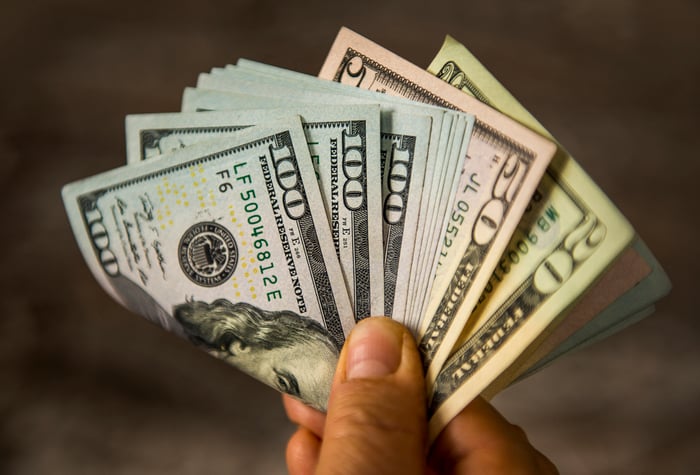Though there is no shortage of strategies to build wealth on Wall Street, buying and holding dividend stocks tends to be a step ahead of the rest.
A decade ago, J.P. Morgan Asset Management, the wealth management division of money-center bank JPMorgan Chase, issued a report that compared the annualized returns of companies initiating and growing their dividends to those of non-payers between 1972 and 2012. The analysis showed that income stocks left the non-payers in the dust -- a 9.5% annualized return over 40 years for the dividend stocks compared to a meager 1.6% annualized return for public companies with no payout during the same span.
The outperformance of dividend stocks over the long run shouldn't be a surprise. Companies that regularly pay their shareholders a dividend tend to be profitable on a recurring basis, can offer transparent long-term growth outlooks, and have previously demonstrated to investors they can successfully navigate an economic downturn. In other words, dividend stocks are perfectly positioned to increase in value over long stretches.

Image source: Getty Images.
But not all dividend stocks are created equally -- even within the benchmark S&P 500 (^GSPC 1.02%). Although around 80% of S&P 500 companies pay a dividend, a handful of S&P 500 stocks stand head and shoulders above their peers in terms of payout size and safety.
If you want to generate $1,000 in super safe annual dividend income, simply invest $12,100 (split equally, three ways) into the following three ultra-high-yield S&P 500 stocks, which sport an average yield of 8.28%.
Verizon Communications: 8.43% yield
The first ultra-high-yield S&P 500 stock that can help you produce $1,000 in annual dividend income from a starting investment of $12,100 (split equally, three ways) is telecom company Verizon Communications (VZ 1.17%).
Legacy telecom companies have two meaningful headwinds to overcome at the moment. The first is rapidly rising interest rates. Since telecom companies are often reliant on debt financing for major projects and acquisitions, higher borrowing rates will make future projects costlier.
The other potential concern for Verizon is a July report from The Wall Street Journal that highlights the use of lead-clad cables by legacy telecom companies. The WSJ report insinuates there's the potential for financial and/or environmental liabilities tied to the usage of lead-sheathed cables.
Though these are both tangible concerns for short-term traders, they're not much of a worry for long-term investors looking for top-notch income.
For instance, any financial liability tied to the use of lead-clad cables would take years to determine by the U.S. court system. The key point being that this isn't an immediate problem for Verizon, nor is it guaranteed to be a concern in the future.
What's far more important is that Verizon's operating performance is slowly but steadily improving because of the 5G revolution. Upgrading its networks to support 5G download speeds is leading to an increase in data consumption, as well as a surge in broadband customer additions. Verizon has added at least 400,000 net broadband subscribers in each of the past three quarters, through the end of June. Though broadband is no longer the growth driver it was two decades ago, it's still responsible for healthy cash-flow generation.
Furthermore, Verizon's retail postpaid churn rate of 0.83% remains near historic lows. Regardless of how well or poorly the U.S. economy performs, consumers have demonstrated an unwillingness to part ways with their smartphone, wireless service, or internet access. This means relatively predictable operating cash flow in any economic climate for a stock valued at less than 7 times current- and forward-year earnings that sports an 8%-plus yield.
Altria Group: 9.18% yield
A second ultra-high-yield S&P 500 company that can generate $1,000 in super safe annual dividend income from a beginning investment of $12,100 (if split equally, three ways) is tobacco company Altria Group (MO -0.37%). Altria is a Dividend King that's raised its payout 57 times over the past 53 years.
The biggest knock against Altria's operating model is that consumers have become aware of the potentially negative health effects associated with long-term tobacco use. Since the mid-1960s, the adult cigarette smoking rate in the U.S. has plunged from around 42% to 11.5%, as of 2021. It means big tobacco companies have a smaller pool of consumers to court, resulting in stagnant to declining cigarette shipments.
Despite this very clear headwind, Altria has a significant competitive edge, as well as tricks up its sleeve to move the needle in its shareholders' favor over the long term.
Altria's front-and-center competitive advantage is its pricing power. Because tobacco products contain nicotine, an addictive chemical, Altria is able to pass along hefty price hikes to offset any decrease in cigarette shipments. Since its Marlboro brand absolutely dominates the premium cigarette market, Altria can continue to move the needle with higher prices.
Beyond just increasing its prices, Altria Group is turning to smokeless products and various acquisitions and investments as a means to diversify its product portfolio. In June, Altria closed its $2.75 billion acquisition of NJOY Holdings, a company that's received six marketing granted orders (MGOs) from the U.S. Food and Drug Administration (FDA) for its electronic vapor products. Very few e-vapor companies have received MGOs from the FDA, which sets Altria up for success in this potentially high-growth channel.
Furthermore, Altria's board of directors has a shareholder-first mentality. After completing a $3.5 billion share repurchase program in 2022, the company's board approved a $1 billion buyback program. Steadily reducing its outstanding share count should provide a lift to earnings per share, which would make its forward price-to-earnings (P/E) ratio of 8 all the more attractive.

Image source: Getty Images.
AT&T: 7.22% yield
The third ultra-high-yield S&P 500 stock that can help you bring home $1,000 in super safe dividend income each year from an initial investment of $12,100 (split equally across all three stocks) is Verizon rival AT&T (T 1.02%). AT&T's 7.2% yield is more than 4 times higher than the roughly 1.6% yield of the benchmark S&P 500.
The challenges AT&T is contending with are effectively the same as Verizon. Higher interest rates will make future projects and debt refinancing costlier, and the WSJ report also alleges that AT&T could contend with financial liabilities tied to its use of lead-sheathed cables.
Similar to Verizon, AT&T responded to the WSJ's claims by pointing out that lead-sheathed cables make up a small percentage of its network. Further, AT&T is providing testing data to the Environmental Protection Agency concerning any public health concerns from its lead-clad cables. AT&T has yet to find any evidence that its lead-sheathed cables pose a public health threat.
AT&T's operating performance is visibly improved, as well, thanks to 5G download speeds. The ongoing device replacement cycle is encouraging people to consume more data, which is music to the ears of AT&T's wireless segment.
The company is also working on a five-year streak of adding at least 1 million net AT&T Fiber customers. AT&T tacked on 296,000 net broadband additions during the third quarter, with 5G speeds fueling what'll likely be a sixth consecutive year of 1 million or greater net adds. Broadband should encourage service bundling, which is a positive for AT&T's operating margin.
Best of all, AT&T's financial flexibility continues to meaningfully improve. When content arm WarnerMedia was spun off and merged with Discovery to create Warner Bros. Discovery in April 2022, the new media entity became responsible for certain lots of debt previously held by AT&T. In addition to cash payments, this spinoff led AT&T to receive more than $40 billion in concessions. Between March 31, 2022, and Sept. 30, 2023, AT&T's net debt has fallen from $169 billion to $128.7 billion. In other words, AT&T's 7%-plus yield is in no danger of being reduced.
Valued at roughly 6 times forward-year earnings, AT&T looks like an absolute steal that should continue to deliver for income seekers.





